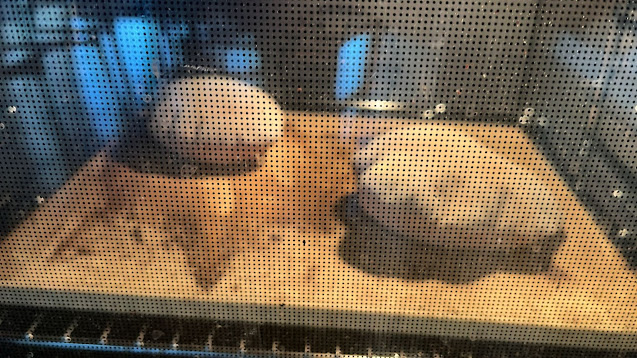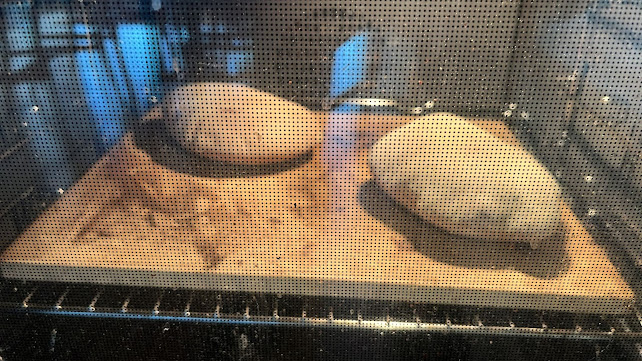Eish Baladi
Welcome to another step-by-step recipe from BreadClub20. Why not drop by our main Facebook page by clicking here... If you like what you see and enjoy the recipe, we hope you join us by 'Liking' and 'Subscribing'.
I remember being in the Sahara desert. We'd travelled by four-wheeled drive via Al Fayoum, about two hours south of Cairo, and then onwards into the vast emptiness of the Sahara, finally setting up camp amongst the dunes.
At dawn, I climbed to the top of the dune and looked out - sand for as far as you could see, rolling sand and ancient rock as far as the horizon.
Below me, the Bedouins, who had brought us here, were making breakfast. Ful Medames, cooked beans and cumin, thick black coffee and Eish Baladi, the staple Egyptian bread, baked on the hot stones around the fire.
 |
| Far away in the distance is my wife and son. |
 |
| Breakfast is being prepared |
On every corner in Cairo, and throughout Egypt, you'll see bakers producing Eish Baladi (also spelt Aish Baladi), a true staple for all Egyptians.
Translated it means, more or less, 'bread of life'. It's that important to Egyptians. It is consumed at every meal.
Bread has been government-subsidised since the days of Nasser. About 60% of the population live close to the poverty line and bread is essential to their diet. Many possess a Subsidy card which entitles them daily to five Eish Baladi per family member. Without a Subsidy Card, you'll pay the going rate for bread from the bakery, Either way, between the subsidised and the more affluent, Egypt consumes 8.5 million tonnes of flour per annum.
 |
| The Subsidy card |
Eish Baladi is gluten-rich and used as much as a utensil as anything. Food is scooped up with it, dipped in sauce and opened up as a wrap for kebabs, falafel and to stop your hands from becoming greasy.
Thanks to Mefreh Aboud back in Al Fayoum for help in making sure this is as authentic as it can be.
 |
| Mefreh, my wife and me! |
The formula from Al Fayoum was leavened by yeast. However, I'm also including a formula which incorporates fermented levain. .
Don't confuse these with pita, neither the Egyptians nor the Bedouins would...
INGREDIENTS
METHOD 1: YEAST-LEAVENED
250 gms wholewheat/wholemeal flour
120 gms white bread flour
240 gms warm water
5 gms crushed sea salt
5 gms caster sugar
15 gms olive oil
8 gms of instant active yeast
For both methods - extra flour for dusting (preferably semolina)
Add all the dry ingredients to a large bowl and mix well
Start to incorporate the wet ingredients, adding the water gradually until the dough is slightly sticky and smooth.
Knead the dough until you have a smooth, elastic dough. Add a little flour or water as necessary to ensure the dough doesn't become too tacky or dry. Kneading should take about 10 minutes.
Place the dough in a lightly oiled bowl, cover and leave in a warm place until it doubles in volume.
Once it has risen, knock the dough back to remove the air and divide it into 6 portions.
Roll each portion into a ball and then flatten it into a disc. Roll the dough into round discs about 1cm thick.
Preheat the oven and a pizza stone / steel sheet to maximum (250⁰C / 480⁰F)
Alternatively you can heat a griddle or heavy frying pan over a medium-high heat.
Once the oven is at temperature,. flour the outside of the discs with semolia flour and then place on the stone. After a couple of minutes, the aish baladi will have bubbled on the top and be golden brown on the bottom. Now flip it over and let it cook on the other side. Pressing gently with a spatula will soften the texture and give it characteristic bubbles.
Remove from the oven and place on a cooling rack. Cover with a cloth to help soften the bread.
Continue until all the eish baladi are baked.
 |
| Yeast-leavened Eish Baladi |
The Yeast-leavened Pocket
METHOD 2: SOURDOUGH-LEAVENED
385 gms wholewheat/wholegrain flour
300 gms tepid water
100 gms active sourdough starter
8 gms crushed sea salt
For both methods - extra flour for dusting (preferably semolina or cracked wheat flour)
Make sure your starter is active and at peak activity.
Mix the flour and salt together.
Add the starter and then gradually add the warm water.
Bring everything together and then knead the dough for about 10 minutes until smooth and elastic.
Place the dough in a lightly oiled bowl, cover it with a cloth, and leave it in a warm place for as long as it takes for the dough to double in volume more or less. The time taken will depend on the temperature and the activity of your starter.
Tip the dough out onto a floured board and, very gently, release the air in the dough.
Divide into 6 portions, shape each portion into a round ball and flatten into a disc 15 cm (6 inches) in diameter.
Dust the discs with the extra flour (see above) and place the discs on a baking sheet, cover them with a cloth and let them rise for 30 - 45 minutes. This is necessary to help them puff up during cooking.
Preheat the oven, and pizza stone (or steel sheet) to 250⁰C / 480⁰F, or heat up a heavy flat pan to medium heat.
Place a dough disc into the oven and let it cook for 2 - 3 minutes until golden brown on the bottom and bubbling.
Turn the dough and let it cook on the other side. Press gently with a spatula to encourage puffing.
Remove the eish baladi and place it on a cooling rack. Cover with a cloth and continue until all discs are baked.
 |
| Sourdough Eish Baladi The Sourdough-leavened pocket. |
Remember, the hotter the oven, the better the eish baladi will 'puff up'.
Happy baking. Eish Baladi takes me back to Egypt and Cairo. As you can see below...it was an interesting day...


















I really like you
ReplyDeleteIf you looking buy Flour Mill for Home, jagruti appliances is a best place. The offered plants can be installed with ease and provide long term service to the customers. Their energy efficiency and high capacity makes them highly appreciated by the customers. Optimum quality materials are utilized for manufacturing these plants that are in strict compliance with industry standards.
ReplyDeleteYum
ReplyDelete